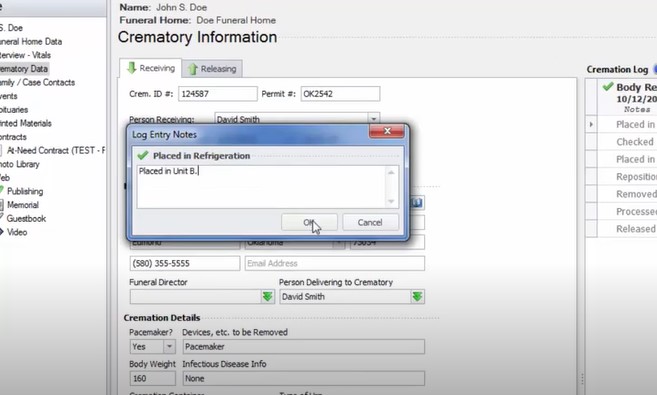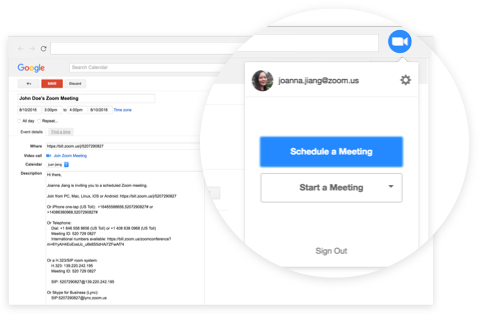Death is an uncomfortable but unavoidable part of life, especially during a pandemic. Software helps businesses in the death-care industry comfort their grieving or worried clients while maintaining social distance.

The van that brought Frankie to the funeral home was now bringing her back home at her family’s request. People stood in the driveway to say their final goodbyes while maintaining a physical distance. Frankie’s grandchildren held signs with love notes scribbled in marker, and the adults raised a final glass to her life. They shouted “We love you, Frankie!” just in case she could somehow still hear through the van windows and purple-shrouded casket.
COVID-19 has disrupted even our most sacred rituals.
“The pandemic has affected nearly all aspects of life, and the way in which people mourn their deceased loved ones is no exception,” said Elizabeth Fournier, owner of Cornerstone Funeral Services in Boring, Oregon. “Families are desperately open to alternatives they never would have considered.”
Funerals are really more for the living than the dead, providing a space for the community to grieve and honor the life of the deceased. The pandemic, however, pushed families and businesses in the death-care industry to rethink how they approach funerals when people were no longer able to gather en masse.
“When people typically think of a funeral home, they think of a large, brick-and-mortar facility; they think of a hearse; they think of a casket; they think of the burial, graveside service, the whole kit and kaboodle,” said Eric Neuhaus, owner and director of Green Cremation in Austin, Texas. “It’s a very physical experience.”
Some might think that businesses in the death-care industry may be among the few to experience job security amidst the crisis, but the industry is not immune to the challenges presented by the novel coronavirus.
Increased demand for funeral home and cremation services extended the turnaround time for remains, causing delays in services. Neuhaus estimated that for two weeks in mid-July, the death rate in Texas rose from 600-700 to 850-900 per day.
“[The spike in deaths] put an extreme strain on the industry and the operations of death care,” Neuhaus said. “Depending on where your funeral home or crematorium [was] located, you could see a 2-3x demand for your services.”
A rising death toll, compounded with social distancing, can present logistical challenges to funeral homes and life insurance agencies trying to build trust with customers.
This is where software comes in.
Keeping up with customers’ evolving expectations and values
Neuhaus, who has been in the death-care industry for eight years, is certain about one thing: Credibility and trust will always be the cornerstone of the industry. What will change, however, is how such businesses establish these values with customers.
"Historically, that’s been done with: how long has the name been out front? How long has your physical funeral home been in town? Moving forward, with the internet, you’re gonna start seeing more and more consumers base [trust and credibility] on digital cues: How many reviews do you have? How trustworthy is your website?"
Eric Neuhaus, Green Cremation
Neuhaus operated online before COVID-19 hit and says his business was well-positioned when the death-care industry went digital.
Here are some of the values businesses in this industry keep forefront to build trust in their brand, paired with lessons on how you can use technology to stay ahead of evolving consumer expectations in your own niche.
4 business values that can build brand trust in uncertain times (and how software can help)
1. Simplicity: Tradition made easier
Robert Falcon founded Affordable Burial and Cremation on the value of simplicity and the fact that not every family has thousands of dollars to spare for a funeral.
“If you need to spend $15,000 to bury your loved one, and it’s not going to put your family in a financial burden, then by all means, do it if that’s what’s going to make you feel good about burying your loved one,” Falcon said. “But most families don’t have $5,000 to spend, and most families are scraping [by] right now.”
Affordable Burial and Cremation was entirely online pre-COVID, and Falcon says simplifying the funeral planning process and replacing in-person arrangements helps him establish trust and credibility with consumers.
"One of the things we’ve learned going to online planning is that it allows them to make decisions based on what they feel is best for them [without] having a salesperson prodding them along."
Robert Falcon, Affordable Burial and Cremation
Using software helps make this process simple for his business, too. Falcon uses Osiris, a funeral home software solution, to manage online arrangements and payments.

Osiris helps funeral directors manage cremation cases (Source)
Technology can help you streamline traditional processes. Think about your customer’s typical journey buying a product or service in your industry. What can be eliminated or simplified to make for a better customer experience?
2. Transparency: Life is uncertain, working with your business shouldn’t be
Along with simplicity and affordability, Falcon also wanted to make his business transparent about cost.
We built our website with our customers in mind. We decided that if we’re going to make things simple for families, we need to make pricing really simple.
Robert Falcon
Affordable Burial and Cremation
While funeral homes are required by U.S. law to disclose costs of services if you call or visit one in-person, funeral homes are not required to put that information on their website. But because simplicity often requires transparency, Falcon turned his website into a menu of services offered, including the cost of each.
This encourages customers to shop around for the option that best fits their family’s needs.
“Consumer education is the backbone of our company,” Falcon said. “We want families to compare, we want families to shop.”
To establish trust, customers need to feel like you’re being honest and transparent with them—no one likes hidden costs and fees. Your company’s website can be an effective platform through which you communicate and show that you’re transparent by providing information (such as pricing).
3. Empathy: Go the extra mile to show you care
Elizabeth Fournier, owner of Cornerstone Funeral Services, considered the needs of her customers. She saw that many families were suffering not just the loss of a loved one but the inability to say goodbye and participate in rituals that gave them comfort.
She offered families the option for video burials and live streamed services using Zoom, a video conferencing platform.

Zoom users can schedule and join video conference calls and virtual events (Source)
While offering this option brought comfort to some families, Fournier wanted to do more to help families “find some peace in saying goodbye.” So, she decided to transport the deceased to people’s driveways to hold viewings.
For families that have members with compromised immune systems or who are unable to leave their homes, this act of empathy allows them to safely experience the catharsis of the final farewell.
Software can help connect you with clients even if you have to stay six feet apart. Put yourself in your client’s shoes to think about what they need. People notice when businesses anticipate their needs and act with empathy.
4. Cooperation: Help your customers understand their options
Ask yourself: Could consumers who aren’t familiar with my industry get easily overwhelmed trying to find a service?
Ty Stewart, CEO of Simply Life Insure, says that the answer to this question is yes, especially at the beginning of the pandemic.
To address this, Stewart says his life insurance agency prioritizes content that explains life insurance to customers.
We’ve doubled down on content creation helping explain some of the most confusing or misunderstood aspects of life insurance these past six months. We put a renewed interest in making that content more educational and empowering right now in a time when a lot of people don't feel very in control of their lives.
Ty Stewart
Simply Life Insure
As a result, the company is seeing a four to six percent increase in website traffic compared to last year and relying on software to grow their content strategy. Buzzsumo, influencer marketing software, helps Simply Life Insure grow their content strategy by monitoring competitors and keywords.

Buzzsumo's content analysis function allows users to see what's ranking for specific keywords (Source)
In turn, Google Analytics (web analytics software) tracks key metrics such as page traffic, pages viewed per visit, and top-viewed articles.
These software solutions help them understand what types of content consumers find most helpful.
Providing people with content explaining the ins and outs of your industry can help them make an informed decision. By investing in a content strategy, you can build a community around your brand.
Software can help ease people’s minds in times of stress
Technology and software can provide stability in times of chaos. Although your normal processes may be disrupted, using software to connect with teams or consumers can simulate a sense of normalcy to ease people’s stress.
If you’re wanting to replace your current software or build a technology stack from scratch, remember, we’ve got you, and you’ve got this.
Learn how your peers are overcoming adversity
Find out how others in the Capterra community are using technology to overcome challenges and learn from one another. We’re in this together.
